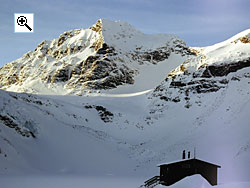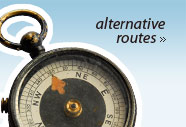Scandinavian Mountains over 2000 metres - James Baxter
Areas › Kebnekaise › 20.3 Gaskkasbákti (2043m)
Gaskkasbákti, also called Kaskasapakte, 2043m is technically the hardest mountain in Arctic Sweden. It has a very alpine nature and although being relatively accessible needs good weather to tackle it. From the summit there are splendid views over the Kebnekaise Range.
| The Route from Tarfalastugan | |
|---|---|
      |
|
There are three routes up Gaskkasbákti, the easiest east ridge, the south east ridge and the classic south west ridge. The latter two are described on the alternative routes page.
The east ridge can be climbed directly from Tarfalastugan cabin or from the neighbouring mountain of Gaskkascohkka. Between these two mountains is a small peak called Lilletoppen where the two routes meet. More information on the route from Gaskkascohkka is on that page.
 From Tarfalastugan cabin head round the east shore of the Tarfalajaure lake the the barely discernable path across stable rocks for 1 km until you are on the north shore of the lake. Leave the shoreline here and start to head up the steep scree slopes to the snout of the Sydvästra Gaskkascohkka-glaciären (south east Kaskasatjåkka glacier) for a good hour. There are a few snow filled gullies which could be firm. At the snout of the glacier, rope up and ascend the 40 degree glacier for an hour until the gradient eases as you approach the saddle between Lillitoppen and Gaskkascohkka.
From Tarfalastugan cabin head round the east shore of the Tarfalajaure lake the the barely discernable path across stable rocks for 1 km until you are on the north shore of the lake. Leave the shoreline here and start to head up the steep scree slopes to the snout of the Sydvästra Gaskkascohkka-glaciären (south east Kaskasatjåkka glacier) for a good hour. There are a few snow filled gullies which could be firm. At the snout of the glacier, rope up and ascend the 40 degree glacier for an hour until the gradient eases as you approach the saddle between Lillitoppen and Gaskkascohkka.
From the saddle head west up the easy east ridge of Lilletoppen to its summit at 1904m. Descend the west ridge over rough rock for 15 minutes until you arrive at the saddle. Here there is a steep 4 metre down climb on loose brittle rock where care is needed. From here continue west for another 200 metres until you reach a metre wide slot. In the dry this can be jumped but in the wet it will have to be downclimbed. Continue west along the narrowing arête for another 200 metres until you reach yet another notch. It is easy enough to descend the 3 metres down into this notch. There is a steep 8 metre grade III climb out of the bottom of the notch for a flatter area on the west side of it.
Here the east ridge proper starts. The ridge consists of a sharp arête with two steep shoulders on it. To the north of the ridge is the magnificent north wall, perhaps the highest and most difficult classic climb in Sweden. The first shoulder is about 60 metres with a good stance half way. The first pitch goes up on the south side of the arête initially up some broken corners and then a slab and is grade III. The second pitch heads up a steep shallow gully across slabs formations to the crest of the arête and is also grade III. Both pitches are quite firm but in the wet they are quite greasy and a grade can be added them.
At the top of these two pitches the arête continues across firm rock for another 300 metres rising quite steeply with the occasional grade II scramble until it gets a bit steeper and reaches a short grade III climb with some thrilling exposure down the massive north face. At the top of this climb you reach the top of the first shoulder at about 1950 metres.
The route now continues west along the exhilarating crest of the arête for 150 metres to the base of the second shoulder. On this relatively horizontal section the route occasionally ventures out over the sensational north face. There is also magnificent view south down the steep south face and over to Giebmegáisi, some 2 km to the south.
This second shoulder is smaller than the first and the climbing is easier. However the rock is far looser and more friable and care is needed. Most of the route up this shoulder is scrambling at grade II. Towards the top of the shoulder the gradient steepens and as the rock here is loose it almost warrants a grade III. This steeper section at the top of the shoulder can either be tackled straight up the arête or on the south side which is less exposed but somewhat looser.
The summit itself is at the top of this second shoulder. The small cairn has a book within a tin buried in it. The easiest descent is by the same route. Here the climbing sections can be abseiled. There are probably 3 abseils altogether with the middle one being the 60 metres up the lower shoulder. This middle abseil can be split in two at a good stance so a single 60 metre rope is suffice for the descent. A good handful of slings are also needed.

